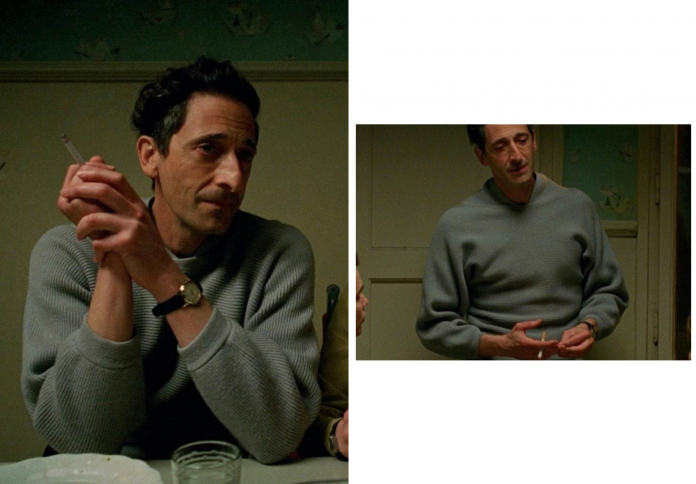The world of cinema often creates unlikely design icons, but few pieces jump from niche vintage garment to must-have luxury item quite like the Brutalist Sweater. Worn by Adrien Brody as the fictional Hungarian architect László Tóth in the film The Brutalist, the original vintage garment captivated audiences and critics alike with its striking, dense structure. Recognizing the intense public reaction, costume designer Kate Forbes collaborated with British knitwear designer Ilana Blumberg to meticulously recreate the piece. This modern reproduction is more than mere film merchandise; it is a profound study in design purity, celebrating the architectural qualities of knitwear and standing as an unapologetic statement against the fleeting trends of fast fashion.
From Costume House to Cinematic Icon: The Vintage Find
The journey of the original Brutalist Sweater began not on a designer’s sketchpad, but within the vast archives of Theatrekunst, a celebrated Berlin costume house renowned for its collection of rare, irreplaceable period garments. Costume designer Kate Forbes, while scouting pieces for The Brutalist, discovered the light grey sweater and immediately recognized its unique potential to define the main character, architect László Tóth.
Forbes was drawn specifically to the garment’s “architectural qualities.” The piece possessed a structural integrity, a density of knit, and a defined silhouette rarely seen in contemporary mass-produced knitwear. She realized the sweater was an ideal, non-verbal extension of Tóth’s modernist ethos and professional commitment. The density and the deliberate lack of fuss mirrored the bold, unadorned nature of the Brutalist architecture the film placed at its center, providing a powerful visual shorthand for the character’s unyielding artistic vision.
The decision to feature the sweater prominently was validated by the ensuing public response. As Forbes noted, the piece was plucked from “anonymity” and instantly became a widely discussed element of the film’s aesthetic, confirming the public’s deep resonance with its modest yet powerful design. This outpouring of appreciation, particularly from design-savvy audiences, provided the impetus for the sweater’s recreation, transforming it from a vintage prop into a commercially viable design project.

The Collaboration: Architects of a Garment
To execute the reproduction, Kate Forbes teamed up with British knitwear designer Ilana Blumberg, a partnership necessitated by the technical complexity of the original garment. Their goal was clear: to retain the absolute essence and architectural silhouette of the vintage piece while making measured adjustments to suit a contemporary consumer audience.
The core challenge lay in replicating the “density of the knit.” Forbes observed that modern manufacturers, focused on minimizing yarn usage for cost-effectiveness, initially produced samples that were “so limp in comparison to the original.” For Forbes, this lack of structure was a fundamental compromise to the piece’s identity. The collaboration demanded a push-back against typical modern manufacturing constraints, ultimately leading to nearly doubling the yarn count to achieve the original’s iconic weight and sculptural shape.
The final reproduction retained the original’s light grey color and its iconic batwing structure in the sleeves and body. Subtle adjustments were made for modern wearability, including creating a deeper rib cuff and extending the sleeve length. These aesthetic decisions were carefully calibrated to maintain the sweater’s unique, flattering shape, which is defined by the way the ribbing at the waist sits snug against the hip, lending a precise fit to the otherwise voluminous body.

Structure as Statement: The Brutalist Aesthetic in Fashion
The success of the Brutalist Sweater is rooted in its deliberate application of architectural principles to knitwear design. Brutalism, derived from the French béton brut (raw concrete), champions the exposed, functional nature of materials and rejects superfluous decoration. This sweater embodies that philosophy. Its structure is its ornament; its density is its definition.
Forbes repeatedly highlighted the garment’s “architectural quality,” arguing that the structure of the collar and the density of the knit give the sweater an independent form—it “really has its own structure.” This design purity appeals to an audience that is “craving really good design and construction” in a market flooded by “fast, cheap fashion.” The garment functions as a wearable protest against the industrial trend toward disposability and material compromise.
The sweater’s uncompromised design aligns perfectly with the broader cultural resurgence of Brutalism in design and fashion. This aesthetic, once polarizing, now represents authenticity, solidity, and a rebellion against the smooth, corporate uniformity of much of contemporary design. By translating the raw, honest ethos of concrete architecture into a comforting yet structurally powerful knit, the Brutalist Sweater captures the zeitgeist of seeking genuine substance.

Legacy and Availability: A Limited-Edition Design Object
The recreation of the Brutalist Sweater transcends simple film merchandising; it is being presented as a limited-edition design object. This positioning ensures its enduring value and maintains the sense of rarity and exclusivity that surrounded the original vintage find.
By meticulously reproducing the unique qualities that made the garment so resonant—the specific density, the unique collar, and the precise, flattering fit—Forbes and Blumberg have successfully commercialized an item that is an active participant in a cultural moment. The sweater acts as a tangible connection between film, architecture, and wearable art. It allows consumers to own a piece of design integrity, rather than simply a movie prop. The decision to invest in the quality of the yarn and the density of the knit, even if it raised manufacturing costs, was critical to maintaining the piece’s artistic value and the integrity of the “Brutalist” concept.










